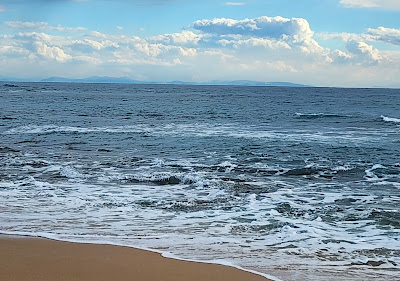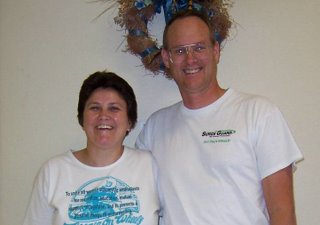 |
| Double-click on photo to read what the Viking Daily had to say about this port of call. |
 |
| Looking out at the harbor, I see this small ferry boat coming in. |
 |
| Looking toward the SE off the bow of the ship, we could see La Plaza de Seville with a fountain and a flag. The building in the middle right is the Cadiz Conference Centre. |
 |
| Above the roof of the Conference Centre, we could see the telecommunications tower on the left and, on the right, the tower on the Iglesia Conventual de Santo Domingo. |
 |
| All I could find on this building is that it houses the Cadiz newspaper. |
 |
| Cadiz was the only part of Spain not conquered by Napoleon. |
 |
| The Cadiz Cathedral towers over most structures in the town. |
 |
| The Cathedral of the Holy Cross over the Waters (Spanish: Catedral de Santa Cruz sobre las Aguas) is a Catholic cathedral built between 1722 and 1838. |
 |
| Mural painted on gym. |
 |
| The artist was given €242,000 euro to do the mural. |
 |
| Las Cigarreras de Cádiz monument |
 |
| Iglesia Conventual de Santo Domingo (Cádiz del Rosario) |
 |
| Portal to the Barrio de Santa Maria quarter |
 |
| The tower on the right is on a building housing a school. The dome in the middle and the tower on the right are the Cathedral. |
 |
| Notice the security grates that can be put over the windshield. |
 |
| Dedicated bicycle path. |
 | |||
| Bóvedas del niño Jesus (Vaults of the Baby Jesus) is attached to the Baluarte de San Roque. A baluarte is a stone structure projecting from the outer wall of a fort built to withstand artillery fire. |
 |
| Paddleboarder |
 |
| Looking over the Gale Sea at the north side of town.. |
 |
| A thin peninsula, just wide enough for a road, leads to the Castillo de San Sebastian, a former island fortress now a destination for historical exhibits, concerts & other cultural events. |
 |
| This is the top of a spiral staircase leading down to the beach. |
 |
| These stone sections with holes in the center are what remains of the Roman aqueduct of Gades. |
 |
| Large recycle bins |
 |
| Christmas decor on children's playground with dragon trees in front. |
 |
| It looks like all the people headed to the Sex Shop have white hair. |
 |
| The baluarte of Santa maria protect the south side of town from invaders. |
 |
| Beach access point |
 |
| Looks like the out-of-towners bring their RV's to stay at the beach. |
 |
| Further along the one line, is an actual train station where you can go to get on a train. |
 |
| The marshy ground here is bisected by man-made ponds. Originally salt pans, these ponds are now home to a sea bass aquaculture business. |
 |
| Flocks of flamingos are often seen in the Zurraque Canal. |
 |
| Fancy hotel |
 |
| These black silhouetted images of a bull are 46' tall by 23' wide. |
 |
| The optimal climatic conditions of Andalusia make it a prime wind turbine area. |
 |
| Tio Pepe, or Uncle Joe, is the dressed bottle and guitar logo for a brand of sherry. |
 |
| Andalusia's plentiful sunshine makes it the best place in Spain for solar panels. |
 |
| There are 164 large, rotating panels in this installation along the highway. |
 | ||
| Andalusian agriculture has been dominated by large estates producing traditional Mediterranean crops such as wheat, grapes, and olives. This is the fallow season |
 |
| Structures in a roundabout where we exit the highway. Windmills are symbolic of the region's agricultural tradition |
 |
| To get to Vejer de la Frontera, we had to travel up the hillside. |
 |
| From the hillside viewpoint, we could look down at the road (lower left), the wind turbines in the distance, and the dragon tree in the foreground. |
 |
| A posts office box. Looks much different from ones in the U.S. |
 |
| The old windmill is called "El Palmar". Our bus in parked right in front of the buildings. |
 |
| We only looked out from this one viewpoint but there are more if you walk around the city. |
 |
| Several sections of the old fortress walls still stand. This is the Puerta de Sancho, the oldest and best-preserved gate to the old town dating back to the 13th century. |
 |
| Mayorazgo Tower. |
 |
| Town Hall is on this square. |
 |
| Arco de la Villa |
 |
| In the tile mural that is found at the entrance to the arch, reference is made to the reconquest of the city and the coat of arms of Vejer is shown |
 |
| Looking down on Plaza Espana |
 |
| The Church of the Divine Saviour from the 16th century is built over the remains of a mosque. The church's architecture is a blend of Baroque, Renaissance, late-Gothic and Gothic-Mudejar styles. |
 |
| Colorful urn on top of building to the left and part of the church arching over an alleyway. |
 |
| Our tour departed to the left of the church. |
 |
| We went down an alley, then I saw a plaque on the wall when I turned around. |
 |
| The Virgin of the Olive is the patron saint of Vejer. |
 |
| Main entrance to the church. |
 |
| The other side of the church. |
 |
| The side of the Church and the old fortress walls surround this walkway. |
 |
| We got back in the bus and start heading to Cape Trafalgar. Fishing is a local industry, and the catch is processed here. |
 |
| Old boat in a roundabout. |
 |
| Interesting cacti along the road. |
 |
| As we can see Morocco as we near the coast. |
 |
| A national bike route runs alongside the road. |
 |
| Umbrella trees |
 |
| The Trafalgar lighthouse was built in 1860. |
 |
| Osprey nest on power pole |
 |
| Only shopping mall in Cadiz. |
 |
| Getting ready to enter the port area, but first we have to go a little further into town. |
 |
| Looks like an elaborate, old gate in front of the dock |
 |
| Gate sculpture. |
 |
| Tops of the gate columns |
 |
| Bye bye Cadiz |





























































1 comment:
Very beautiful photos and descriptions about this one-day trip. We are going to take this trip by Viking in the coming of November, 2025. Thank you for sharing.
Post a Comment